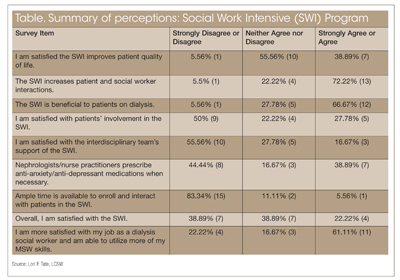Perceptions of the social work intensive program for addressing anxiety and depression in patients with ESRD
Depression and anxiety are common quandaries in patients on dialysis. These issues impact patients’ overall health. The social work intensive program offers one-on-one brief interventions with patients on dialysis. These interventions offer assistance to patients on dialysis in an effort to maximize wellness benefits. Social workers provide these interventions based on quality indicators and clinical judgement.
This study reports social workers’ perceptions of the social work intensive program in the Southwest Mississippi and Louisiana region. Due to the small sample size and the use of descriptive information only, more research is needed to determine the effectiveness of the program. This study only reviewed social workers’ perceptions, and a review of comparative data to include patients’ perceptions is warranted.

Introduction
Twenty-six million Americans have kidney disease; or one in nine persons.1 Patients with ESRD require dialysis treatments to sustain life. The occurrence of depression and anxiety among patients with ESRD is thought to be four-times higher than the general population.2 One study suggests depression in this population is “the most common comorbidity.”3 Anxiety issues most commonly include nervousness related to needle phobia and pain.4
The social work intensive program offers one-on-one brief interventions with patients on dialysis to aid in optimal health and wellness.5 This program offers various interventions that teach patients ways to handle anxiety, stress and depression.5 The program does not offer assistance with chronic, long-term mental health issues such as bipolar disorder, any diagnoses pertaining to drug and alcohol use or psychotic episodes. These patients are referred to mental health professionals trained to work with these specific diagnoses.5
Purpose
The aim of the study was to report dialysis social workers’ perceptions of the social work intensive program. Patients are enrolled in the program based on difficulties with seven quality indicators: missed treatments, patient-shortened treatments, low albumin or protein levels, elevated phosphorus levels, excessive fluid intake, unwillingness to have a dialysis catheter removed and have a permanent dialysis access placed and medication management.5
Social workers may use clinical judgement and enroll patients based on other indicators such as depression, anxiety or grief related issues as well. The number of patients added to the program is based on social workers’ case load size; those numbers are determined by lead social workers and administrators. For example, with a case load of 150 patients, a social worker may have up to four patients enrolled in the intensive program at a time. Social workers can keep a wait list to add patients as appropriate to the program.
Methods
The survey instrument consisted of 10 questions. The initial question was a simple yes or no question concerning active participants in the social work intensive program. The following nine questions used a Likert scale to gather descriptive statistics about patient involvement, patient and social worker interactions, and social workers’ satisfaction regarding the program.

Participants were recruited via email. Participation was voluntary; no additional incentives were provided to social workers based on participation. Social workers in the Southwest Mississippi and Louisiana region were provided an email with the survey link using the 2018 copyrighted Survey Monkey program. To ensure anonymity, participants were not required to provide any demographic information. Of the 37 social workers in this region, 18 responded and completed the entire survey.
Results and limitations
Descriptive statistical results were analyzed by the 2018 Survey Monkey program. Of the 18 participants, one respondent did not have an active patient enrolled in the program. Findings suggest social workers, in this region, are seemingly satisfied with the social work intensive program and the overall benefits to patients (See Table). However, more time and support from the interdisciplinary team may be indicated.
Limitations to the study include, but are not limited to, descriptive information, a small sample size and perceptions of social workers only.
Further research of the social work intensive program is necessary to determine its effectiveness. This study was a small sample and only reviewed descriptive results. Additional studies to determine patients’ perspectives of the program are warranted. Comparative studies between both patients and social workers will provide additional information for renal professionals.
- References:
- 1. Mississippi Kidney Foundation. Accessed from www.kidneyms.org.
- 2. AlDukhayel A, et al. International Journal of Health Science. 2015; 9-16.
- 3. Yeh C., et al. Renal Failure. 2014;1545-1549.
- 4. Kidney Buzz. The realities of dialysis: Needle phobia and pain. What can CKD patients do? Accessed from www.kidneybuzz.com.
- 5. Fresenius Kidney Care. Thrive with Ultracare: Social Work Intensive. 2013.
- For more information:
- Lori F. Tate, LCSW, is a clinical social worker with Fresenius Kidney Care in Brookhaven, Mississippi and is completing her doctorate in social work at Tulane University in New Orleans. Disclosure: Tate reports no relevant financial disclosures.
